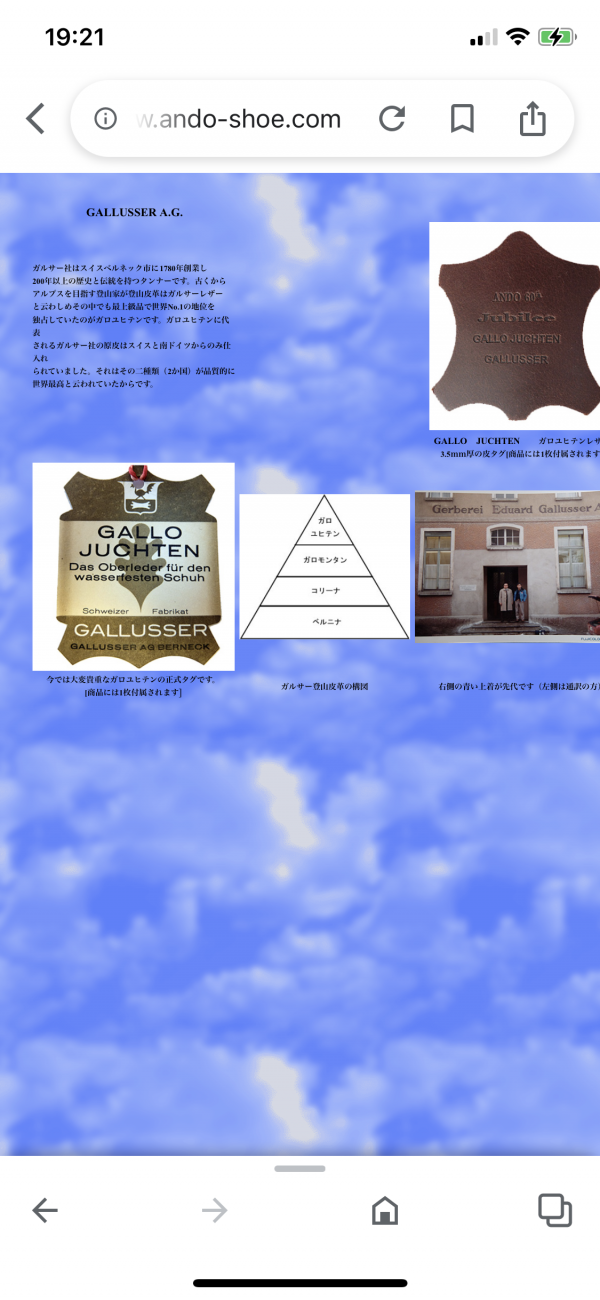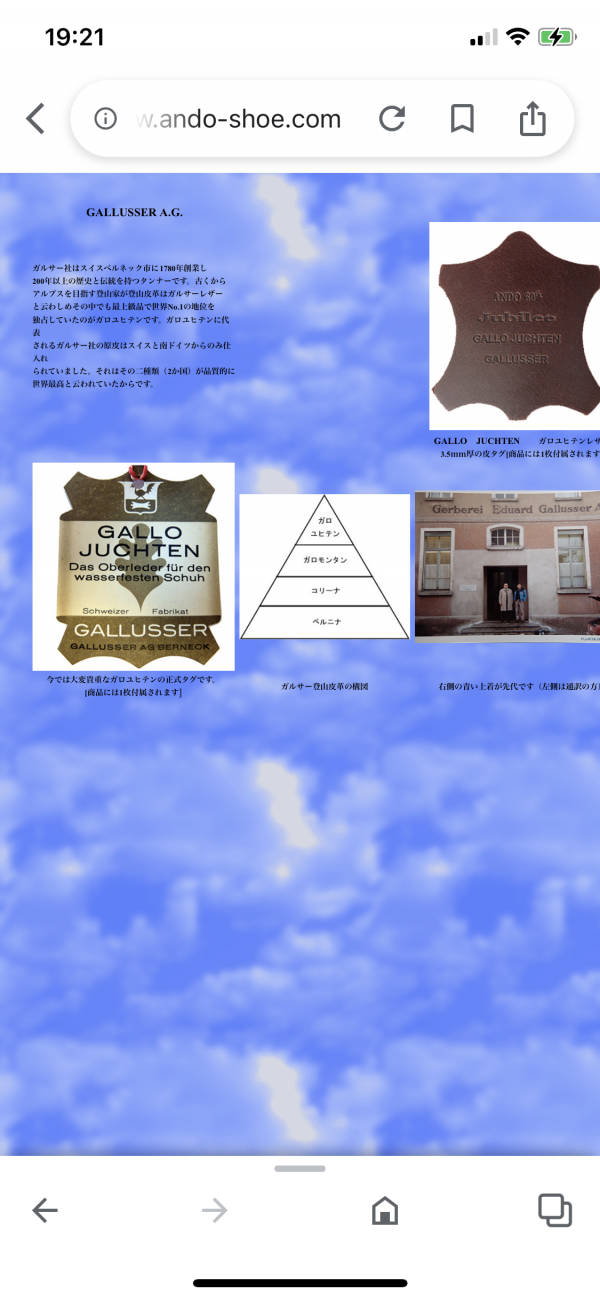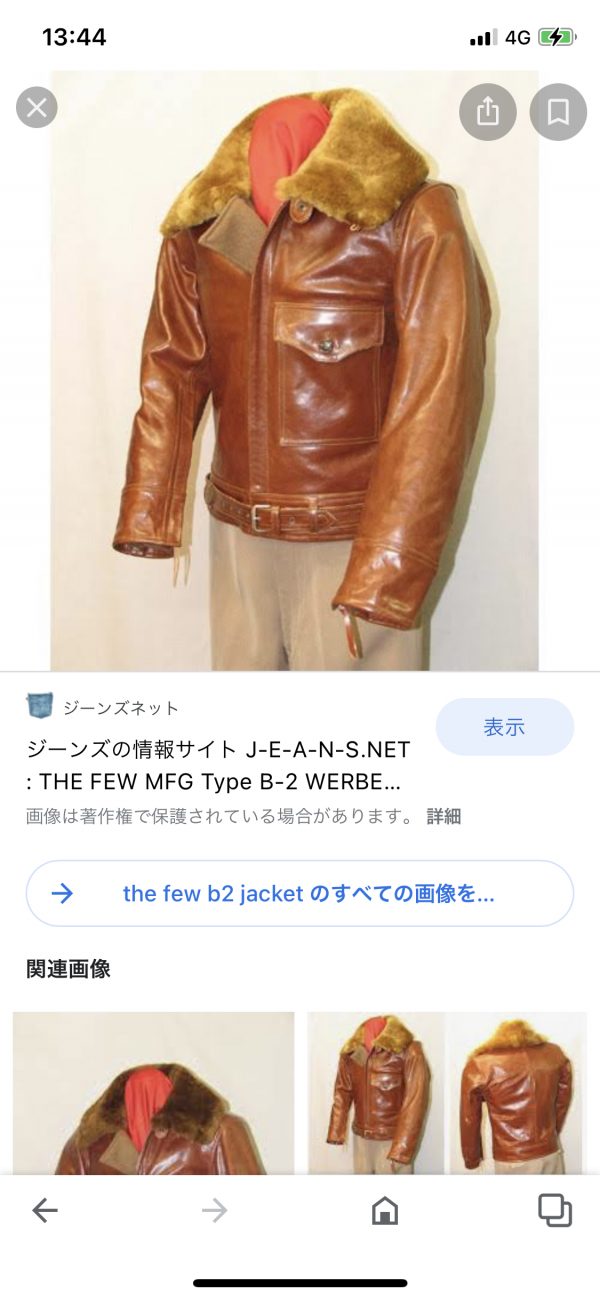Want to buy or sell something? Check the classifieds
-
The Fedora Lounge is supported in part by commission earning affiliate links sitewide. Please support us by using them. You may learn more here.
You are using an out of date browser. It may not display this or other websites correctly.
You should upgrade or use an alternative browser.
You should upgrade or use an alternative browser.
Scarecrow Yah Ta Hey leathers
- Thread starter Guppy
- Start date
Of course, happy to help!Thank you for such a great answer!
I will stick to steerhide.
So most jackets up until the 60s were made from horsehide because of how prominent horses were. They were our primary transportation, they were used for work, and many places also raised them for food. Which means we had a lot of horses, and a lot of dead horses so they were used for jackets. As things started changing throughout the first 60 years of the 1900s cows became the more prevalent farm animal and production was switched to steer as the primary leather of jacket making. Horse is much more expensive these days not necessarily because it’s so much better than steer/cow but because it’s harder to get a hold of. Horses are not nearly as prominent as they used to be; and many nations actually passed laws saying horses could not be bred only for tanning purposes. For example here in the US they cannot be. If a tannery chooses to work with horses they have to die from old age/disease or be like racing horses that were put down due to injury. So it makes it a lot harder and more scarce to get a hold of. And that’s what leads to higher prices. Plus horses themselves have a lot less surface area that is actually able to be used for jacket making. Where as cows have a ton of surface area that jacket makers can use comparatively of course. A lot of reproduction companies and vintage inspired makers will work with horse simply because that’s what the originals were made of. But not because horse is some super amazing leather that’s so much better than cow.I hear that Shinki Hikaru Co.Ltd. is a tanner in Japan which is dedicated to horsehide.
Horsehide jackets are about 50~100% more expensive than the steerhide version of the same jacket.
Last edited:
Once again happy to help. The one thing people need to be wary of and especially new collectors. I mean I fell for it myself until I started researching the subject is the marketing a lot of companies use when they talk about horse. They make it sound like it’s so much better than all other leathers, they make it sound like some magical-mystical leather and it’s really no different than steer! As I mentioned it’s more scarce which raises the cost a bit, and it’s a bit more water and tear resistant but it looks identical to steer and any differences in water and tear resistance can be overcome based on tanning method or finishing methods. I’ve spoken with leather workers, jacket makers, and boot makers and they all have pretty much said they can’t tell the difference. And that’s coming from people with the highest training and decades of experience. They may be able to tell if they have a Powerful microscope because horse has a tighter grain and tighter internal fiber structure (which is why it has a bit better resistance because it’s wound tighter together locking out more water and making it harder to tear) but that’s about the only way to tell.You know, you can be a university professor about this subject!
But I’ve seen some makers that go on and on about how fantastic horse is and how you just have to have it if you want the best. In reality they are probably selling it so hard to try and justify their up charge on it. Or they have fallen in love with the history of the product. Since horse used to be so common as I said until the 50s-60s horse was the most common jacket leather. There is some romance, history and myth there. But there’s no huge difference in the 50s-60s when the big switch to steer happened. Buy whatever you can afford and whatever you enjoy. I’ve never owned a moose hide jacket though I hope to one day; but I have had moose boots and I think that might be one of my personal favorites. As I said in my last post it’s super thick, has really unique grain, since it’s a wild animal the hides come with cool scars and bug bites yet it’s also very flexible and soft. Best of both worlds really -the thickness and beefiness of a tank, but almost no break in required and a very easy wearing leather. So buy whatever you enjoy and remember moose, steer and horse can end up all looking and feeling the same in the end anyways because much more so than the hides chosen the tanning method and finishing touches play the biggest roles! Veg, chrome, or combo…hot stuffed with wax and/or oil, painted on finish, dyed, dyed through or teacore, lacquer applied, weather proofing applied. So many options and choices in todays world.
Last edited:
Once again happy to help. The one thing people need to be wary of and especially new collectors. I mean I fell for it myself until I started researching the subject is the marketing a lot of companies use when they talk about horse. They make it sound like it’s so much better than all other leathers, they make it sound like some magical-mystical leather and it’s really no different than steer! As I mentioned it’s more scarce which raises the cost a bit, and it’s a bit more water and tear resistant but it looks identical to steer and any differences in water and tear resistance can be overcome based on tanning method or finishing methods. I’ve spoken with leather workers, jacket makers, and boot makers and they all have pretty much said they can’t tell the difference. And that’s coming from people with the highest training and decades of experience. They may be able to tell if they have a Powerful microscope because horse has a tighter grain and tighter internal fiber structure (which is why it has a bit better resistance because it’s wound tighter together locking out more water and making it harder to tear) but that’s about the only way to tell.
But I’ve seen some makers that go on and on about how fantastic horse is and how you just have to have it if you want the best. In reality they are probably selling it so hard to try and justify their up charge on it. Or they have fallen in love with the history of the product. Since horse used to be so common as I said until the 50s-60s horse was the most common jacket leather. There is some romance, history and myth there. But there’s no huge difference in the 50s-60s when they big switch to steer happened. Buy whatever you can afford and whatever you enjoy. I’ve never owned a moose hide jacket though I hope to one day; but I have had moose boots and I think that might be one of my personal favorites. As I said in my last post it’s super thick, has really unique grain, since it’s a wild animal the hides come with cool scars and bug bites yet it’s also very flexible and soft. Best of both worlds really -the thickness and beefiness of a tank, but almost no break in required and a very easy wearing leather. So buy whatever you enjoy and remember moose, steer and horse can end up all looking and feeling the same in the end anyways because much more so than the hides chosen the tanning method and finishing touches play the biggest roles! Veg, chrome, or combo…hot stuffed with wax and/or oil, painted on finish, dyed, dyed through or teacore, lacquer applied, weather proofing applied. So many options and choices in todays world.
Thank you again for an excellent explanation which can’t be seen anywhere. I started to doubt about horsehide being so much better than steerhide when I saw this Gallo-Juchten leather which is cowhide made by a Switzerland tannery called View attachment 413395
I’m sorry. The reply was interrupted.
I started doubting about horsehide being much better than cowhide when I saw this article about the tannery in Switzerland called Gallusser and their steerhide called Gallo-Juchten leather. It’s used to make the old fashioned all-leather mountain boots such as Meindl Super Perfekt and Galibier Super Guide. If horsehide is so much better than steerhide, Gallusser might have used horsehide.
Your answer gave me all the information I needed.
I started doubting about horsehide being much better than cowhide when I saw this article about the tannery in Switzerland called Gallusser and their steerhide called Gallo-Juchten leather. It’s used to make the old fashioned all-leather mountain boots such as Meindl Super Perfekt and Galibier Super Guide. If horsehide is so much better than steerhide, Gallusser might have used horsehide.
Your answer gave me all the information I needed.
Attachments
These are the mountain boots that’s made of Gallo-Juchiten leather. It’s approximately 8 ounce (3.5 mm) thick. The 1st 2 photos are Kamoshika Sporting goods made Chomolungma. 3rd and 4th photos are Ando Seika made Pulse 7000G. They’re both made in Japan. The last photo is Scarpa Blenta boots made in Italy.
Mountain climbing is popular in Japan though only a fraction of climbers actually climb the highest mountains.
Mountain climbing is popular in Japan though only a fraction of climbers actually climb the highest mountains.
Attachments
-
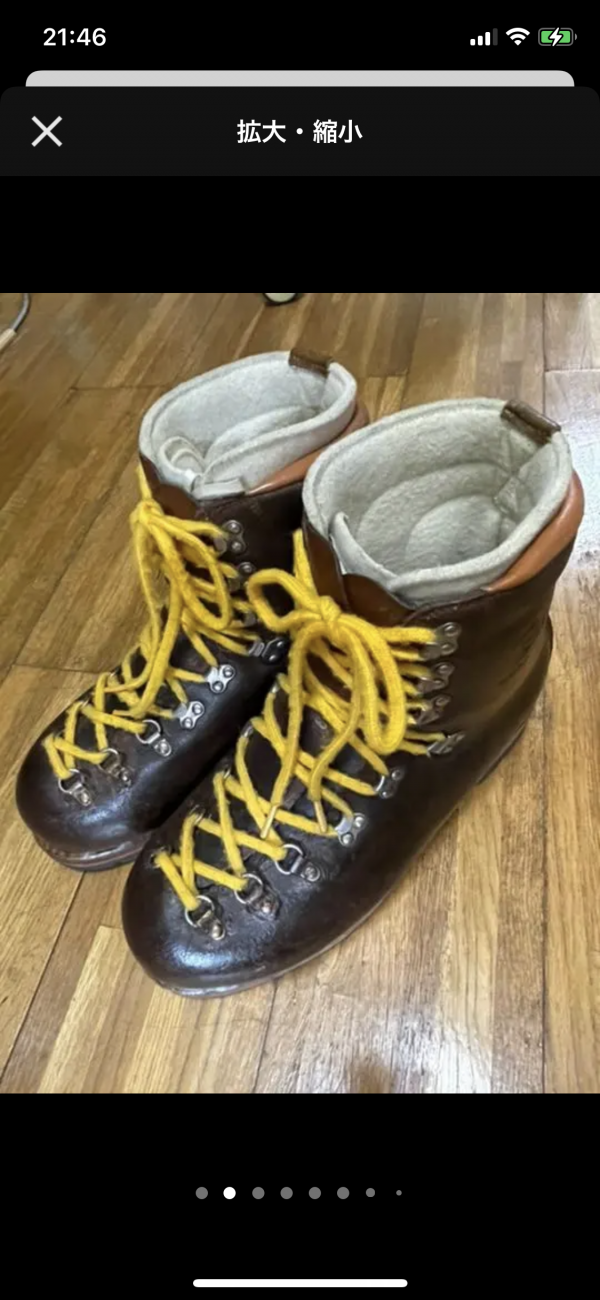 8D880815-6855-4C4E-A4C4-8225DAF843BA.png7.6 MB · Views: 101
8D880815-6855-4C4E-A4C4-8225DAF843BA.png7.6 MB · Views: 101 -
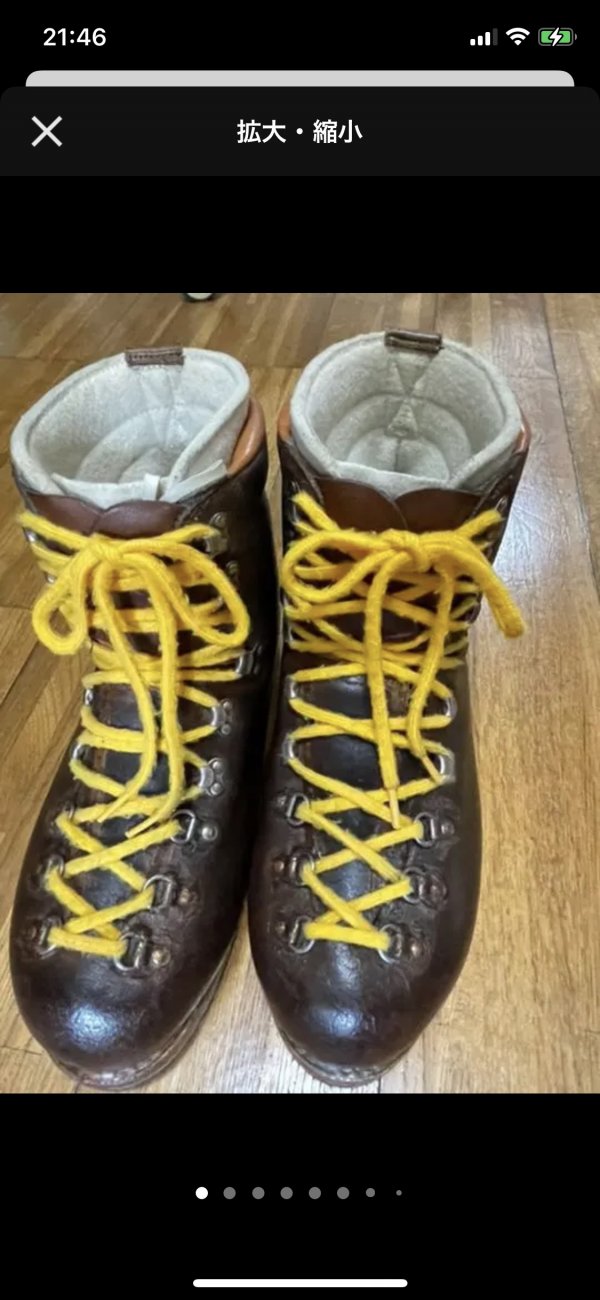 4B70B4FA-F07A-4983-BB59-1506FAC6774E.jpeg366.6 KB · Views: 99
4B70B4FA-F07A-4983-BB59-1506FAC6774E.jpeg366.6 KB · Views: 99 -
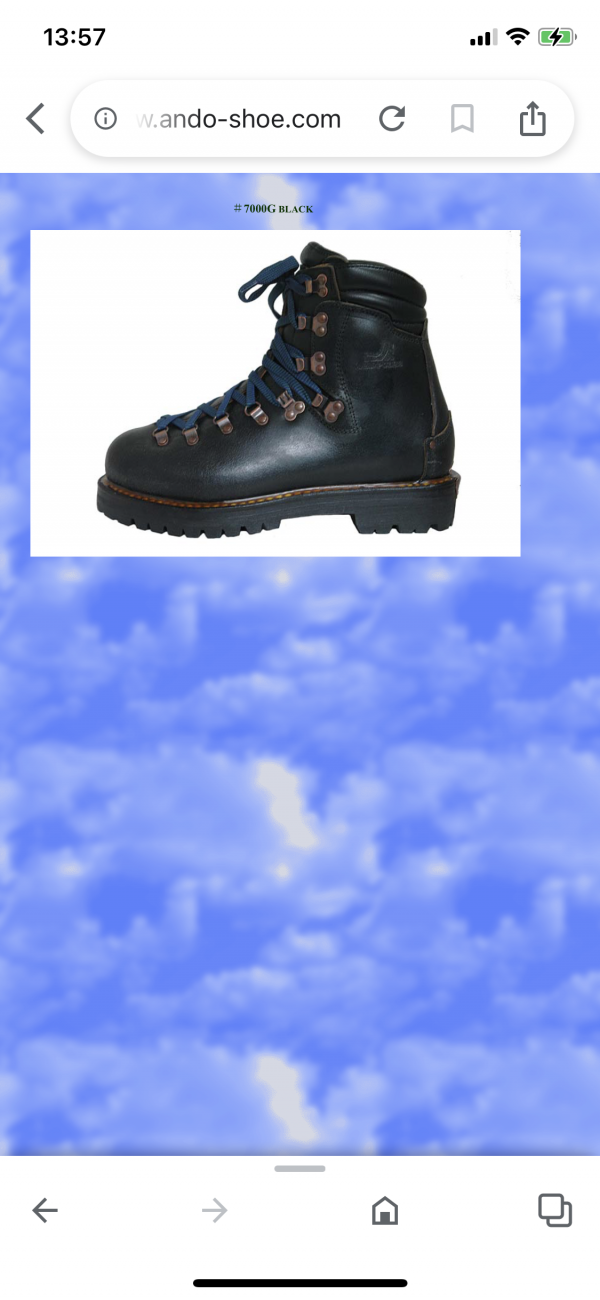 10BB6457-0159-4F3A-87A5-8A8A9706CAEF.png2.5 MB · Views: 102
10BB6457-0159-4F3A-87A5-8A8A9706CAEF.png2.5 MB · Views: 102 -
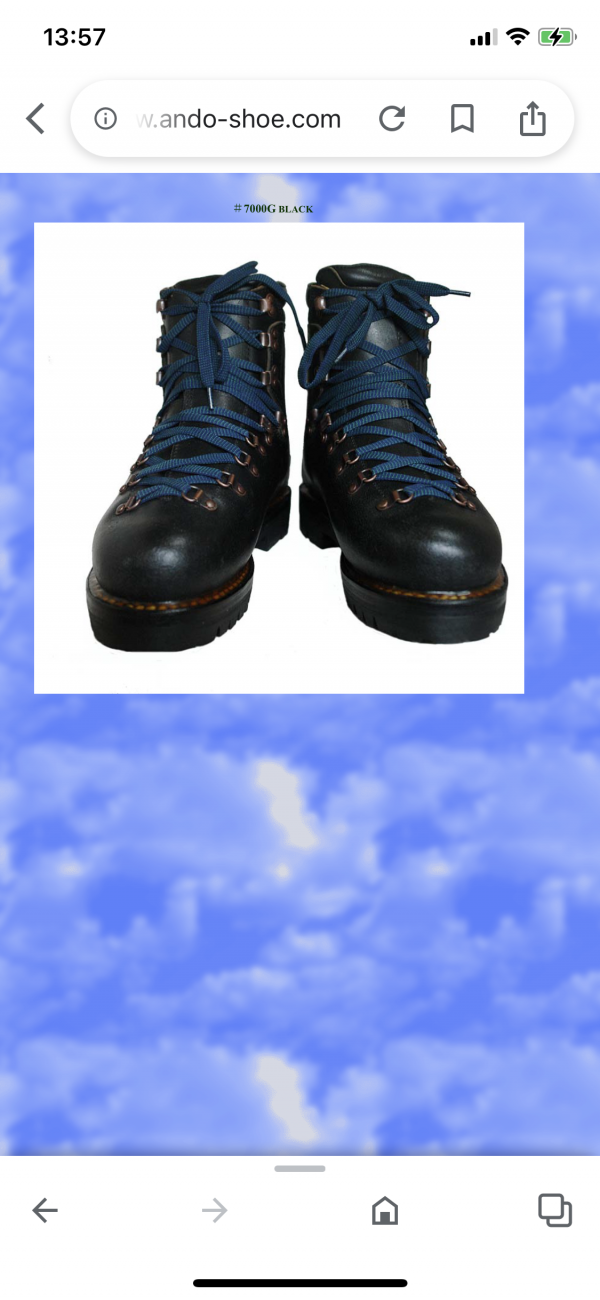 6111A2CA-38FC-4FDC-8496-673D644D048E.png3.2 MB · Views: 106
6111A2CA-38FC-4FDC-8496-673D644D048E.png3.2 MB · Views: 106 -
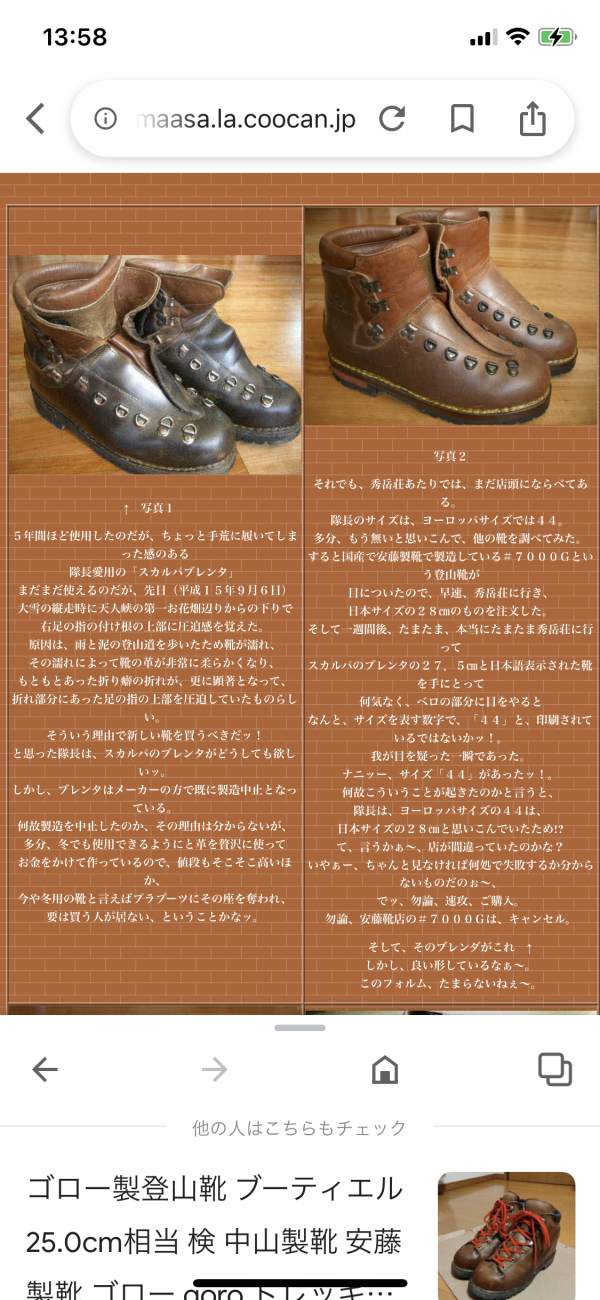 3D6CFDCE-A2D2-44F2-8795-7BB435D131E7.png3.3 MB · Views: 126
3D6CFDCE-A2D2-44F2-8795-7BB435D131E7.png3.3 MB · Views: 126
Hh121
Banned
- Messages
- 3,004
Any particular reason that you choose this bull hide? @Arrandale
Featured products
-
 John Lofgren Monkey Boots Shinki Horsebuttt - $1,136 The classic monkey boot silhouette in an incredibly rich Shinki russet horse leather.
John Lofgren Monkey Boots Shinki Horsebuttt - $1,136 The classic monkey boot silhouette in an incredibly rich Shinki russet horse leather. -
 Grant Stone Diesel Boot Dark Olive Chromexcel - $395 Goodyear welted, Horween Chromexcel, classic good looks.
Grant Stone Diesel Boot Dark Olive Chromexcel - $395 Goodyear welted, Horween Chromexcel, classic good looks. -
 Schott 568 Vandals Jacket - $1,250 The classic Perfecto motorcycle jacket, in a very special limited-edition Schott double rider style.
Schott 568 Vandals Jacket - $1,250 The classic Perfecto motorcycle jacket, in a very special limited-edition Schott double rider style.
Guppy
I'll Lock Up
- Messages
- 4,407
- Location
- Cleveland, OH
They don't believe that such heavy leather is needed, and they have apparently had customers order it only to be dissatisfied when they found it impractical to actually wear. There seems to have been a little arms race that people wanted to keep pushing for the thickest, heaviest ever, and they finally decided to put the foot down.Does anyone know why Langlitz discontinued making jackets from heavy weight leather?
Canuck Panda
I'll Lock Up
- Messages
- 5,017
@Arrandale Langlitz uses the motochap (3.5oz) cowhide from The Hide House (in Nappa). Same place your 7oz Bull hide came from (I think). So there is some similarities? Just yours is twice as thick.
Did you get the package yet? Please post some photos of the jacket when you get it!
Did you get the package yet? Please post some photos of the jacket when you get it!
After all the best riding gear is made in Kangaroo which is not the thickest nor the heaviest leather.They don't believe that such heavy leather is needed, and they have apparently had customers order it only to be dissatisfied when they found it impractical to actually wear. There seems to have been a little arms race that people wanted to keep pushing for the thickest, heaviest ever, and they finally decided to put the foot down.
Sure, I will. Thank you for the information.@Arrandale Langlitz uses the motochap (3.5oz) cowhide from The Hide House (in Nappa). Same place your 7oz Bull hide came from (I think). So there is some similarities? Just yours is twice as thick.
Did you get the package yet? Please post some photos of the jacket when you get it!
Is kangaroo leather light and at the same time durable?After all the best riding gear is made in Kangaroo which is not the thickest nor the heaviest leather.
Similar threads
- Replies
- 17
- Views
- 2K
- Replies
- 10
- Views
- 2K
- Replies
- 55
- Views
- 17K
Members online
- dangibbons1981
- TiltRotorFlyer
- tweedydon
- Kfz
- jchance
- Mankohouse
- Jasonissm
- DonR
- smittybat
- DavidT
- Bfd70
- pillepalle123
- DaveProc
- rogueclimber
- PeterHuang
- karlito
- Tyler Durden
- FindingSerenity
- TZRZ421
- stmike
- powersci
- jeffgarf
- keruan
- G007
- Frunobulax
- quikrick
- StoryPNW
- The Hatted Professor
- Gary in NC
- coolhandluke_7
- Herrvallmo
- dinhnguyen57
- murphykobe
- zebedee
- codex
- Jimmy__patt
- MShreyas
- Cskarev
- postman10mm
- Santa
- soreilly
- nickv
Total: 3,555 (members: 58, guests: 3,497)
